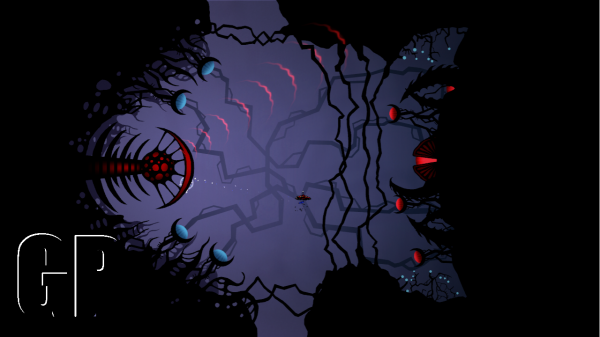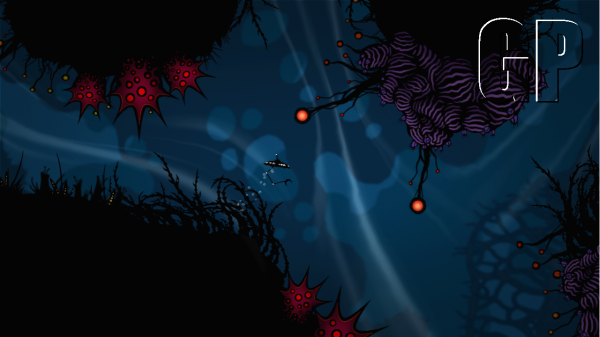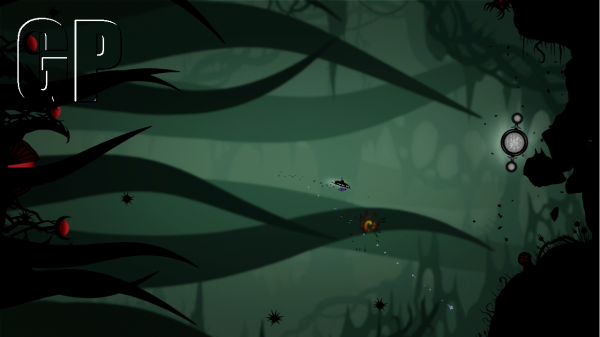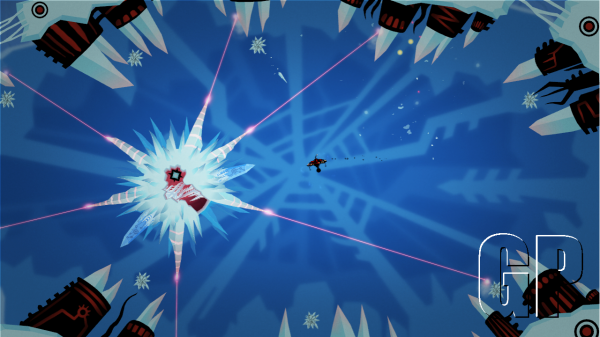Have you ever sat and thought, “Man, if only I could combine a shmup like Ikaruga or Defender, and use that gameplay to adventure through a world and collect power-ups like in Metroid or Castlevania, all the while exploring a B-movie sci-fi story in a distant star system”? If so, then Insanely Twisted Shadow Planet is the game for you. If not, you could still have a pretty good time indulging in that overly-specific fantasy.
I booted up the game knowing literally nothing about it, save the wordy title. Shadow Planet Productions’ game seemed a lot like a modern graphic art student’s dream; dark, quirky and bizarre animation coupled with smooth flowing gameplay. In short, very much like Playdead’s brilliant art/puzzle piece Limbo. However, unlike Limbo, ITSP endeavours to build more gameplay meat onto its well-animated bones.
I mentioned Metroid before, because ITSP mimics a lot of that seminal series’ structure and design. This is where the similarities with Limbo diverge greatly. You begin with a basic flying saucer. That’s right: for the entirety of the game you play a bog-standard looking UFO. Initially it only has the ability to scan: a little radar dish pops out of its underbelly, and with the right stick and a trigger you can scan any interactive (or hostile) objects around you, showing you their vulnerabilities or dangers. You progress from this modest opening in a very Metroid manner: a square-based map shows points of interest and your destination, and as you proceed you get more abilities and upgrades for your saucer, from a bog-standard plasma blaster to a rather excellent waldo grabber (with the ability to grab physics’ed objects).
The interaction of these concepts works sometimes, but most of the time, not so much. In the sometimes, abilities like the scanner offer lovely, little, true-sci-fi touches; for example, when entering new themed-areas on the eponymous Shadow Planet, good practice is to proceed slowly, swinging your scanner dish about for any signs of movement. The feeling of exploring an alien world is developed best in these parts, when the abilities and exploration complement the mystery and pacing. For the rest of the game, however, the pacing feels a tad off. You shoot through areas with a shmup’s giddy sense of speed, but the actual development of the gameworld and challenges doesn’t keep up. It feels like you are flying through something with great momentum, when it should really be taken slowly and absorbed like a fine insanely twisted wine.
This broken pacing is my main issue with the game. I prefer it when games take a slow-burning approach to adventures and gameplay. However, in ITSP, it isn’t just the gameplay-versus-level pacing that feels off, but the actual time it takes to complete the game. Each themed world (from water to organic to electrical) takes around 30 to 60 minutes to complete, and aside from the tutorial area, there are really only six of these in the game. After a few hours, I had completed 54% of the world map, and nearly 50% of the actual game overall. Add to this the fact that ITSP is really not a difficult game, and things start to look bad for it. The learning curve is incredibly shallow until the last few minutes, when suddenly it ramps up significantly (i.e. the last boss is tough as hell).
Despite these shortcomings, a couple of other factors add some longevity and challenge to the experience (though they don’t entirely make up for the generally small singleplayer adventure). For one, there are various collectibles in the gameworld that require backtracking or a little puzzling to reach: concept art that is often interesting, ‘artifacts’ that show you the Shadow’s invasion of the planet from the ground, and upgrades for weaponry. Considering how quickly you can manoeuvre through the world, though, this doesn’t actually add too much time on to the experience. Missed collectibles are marked on your map, either from you scanning them or their area being greyed out until exploration, so you know exactly where to go. The main feature that could add a fair bit of longevity is the game’s multiplayer mode: the Lantern Run.
The Lantern Run sees four players fleeing from a massive, screen-sweeping tentacled monster. At the same time, the players must protect their own ‘lanterns’ (objects used later in the singleplayer game to transfer electrical charges), dragging them away from the monster whilst completing randomly generated waves of enemies and obstacles. This makes for surprisingly tense and panicked games: players pulling rocks out of the way to fit their lanterns through, rushes to grab power-ups, flying back to help someone who is trapped with the monster.

Probably the most exciting aspect of the Lantern Run is that it is not strictly competitive; but neither is it co-operative. The level goes on forever, getting harder and harder, meaning the players have to help each other more as the game continues, but what happens when the lanterns are lost? Everyone gets scored. The scoring system is based around the number of enemies killed, how many times the players’ UFOs died, and how long their respective lanterns lasted. Suddenly, grabbing the powerups for yourself or killing more enemies while another player dies is worth it. Or even dropping that rock which you just cleared out of your path, so that the guy behind you gets trapped with the monster. The betrayal possibilities are endless!
But, unlike the betrayal possibilities, even the Lantern Run’s joys aren’t endless. It feels like a good minigame: fun for an hour or so, but that’s enough (until days or hours later when you crave it again). Overall, Insanely Twisted Shadow Planet is rather good, but a bit light on content and flawed in pacing. I feel if Shadow Planet Productions had focused their brilliant artistic and design work slightly more towards a slow burning hard-sci-fi approach, the game would have turned out an absolute gem. As it stands, ITSP is definitely worth playing, but not at its current price of 1200 Microsoft Points.
Developer: Shadow Planet Productions
Genre: Shoot ‘em up/side-scrolling adventure.
Time: 5-6 hours (give an hour or two more depending on your level of ‘collectible OCD’ and multiplayer funtimes)
Gripes: Not enough content in singleplayer, arcadey pacing doesn’t fit with open world adventuring, too easy (until the end)
Get it for the: Extremely unique style and a clever, fun mesh of game mechanics
Full Disclosure: Press X or Die received a review code from the developers. Played to completion, and played multiplayer for a series of matches. Again, purposefully didn’t disclose too much of the game’s progression or abilities as they are nice to discover.



